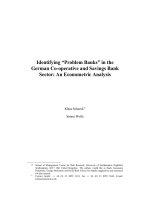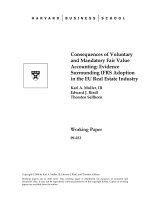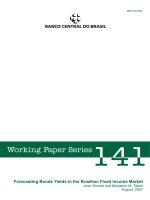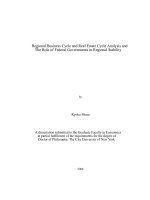Transparency in the German real estate market – Results and problems, chances and new developments doc
Bạn đang xem bản rút gọn của tài liệu. Xem và tải ngay bản đầy đủ của tài liệu tại đây (187.6 KB, 8 trang )
Carla Seidel 1/8
Transparency in the German real estate market
FIG Commission 9, CIREA and HKIS Symposium – Property Valuers Fronting the Triple Bottom Lines of
Economic, Environment and Social Conflicts
Xian, China P. R., 16-20 October 2005
Transparency in the German real estate market –
Results and problems, chances and new developments
Dipl Ing. Carla SEIDEL, Germany
Key words: Land valuation boards, digital purchase price collection, standard land prices,
valuation GIS, land taxation, location analysis, geo-risk areas
ABSTRACT
According to the German law, independent and self-employed land valuation boards support
the transparency in the real estate market. The idea is that all transactions in the schedule of
purchase prices are recorded and collected in the Digital Purchase Price Collection. The
database are published and will be used for generalize price contour maps and for property
market reports.
In our time of electronic databases and the World Wide Web the way of registration,
collection, evaluation and output of the database has changed from analogue to digital. Some
of the land valuation boards already offer their information in the Internet. The land valuation
board in Berlin was the first one in Germany that installed an Internet presentation. Although
other firms present a geoportal for collecting information in the Internet as well, the
information provided by the land valuation boards are more broaden and therefore improve
the daily work for real estate valuation substantially.
The Digital Purchase Price Collection is like a Geographic Information System (GIS) for the
property market. It will be used by the public and the private sector. Currently, the German
government discusses how the price contour maps can be used for land taxation.
Besides of that, the Digital Purchase Price Collection serves as a very good instrument for
location analyses (e.g. for companies) and for price developments in global risk areas (areas
affected by Hurricanes or flood).
Carla Seidel 2/8
Transparency in the German real estate market
FIG Commission 9, CIREA and HKIS Symposium – Property Valuers Fronting the Triple Bottom Lines of
Economic, Environment and Social Conflicts
Xian, China P. R., 16-20 October 2005
1. INTRODUCTION
In Germany there are essentially two types of valuator. On one side there are the independent
private valuation experts. This valuators have different qualifications, e.g. “ö.b.v.S.” by the
IHK (industrial- and trade-association), “HypZert” by the banks or a title by the RICS (Royal
Institution of Chartered Surveyors) FRICS (fellow) or MRICS (member). Additional are to
call “ÖbVI” – surveyors with a special profession for public tasks.
On the other side there are the public institutions – the “public valuation boards”
(“Gutachterausschüsse für Grundstückswerte”).
2. LAND VALUATION BOARDS
These committees are responsible for a certain area, for example Berlin, Munich, Dresden,
Hamburg and so on. Each public valuation board has about 10 to 20 members.
The tasks of the official committees are fixed in § 192 and the following in the German
federal building code (“Baugesetzbuch”(BauGB)). The most important task of the land
valuation boards is to make the results of the local real estate markets more transparently for
citizens and experts.
The main jobs – ordered by law – are the following:
to public real estate market reports (“Grundstücksmarktberichte”) (in generally one per
year)
to write valuation reports (“Gutachten”) for built-up and non built-up real estates for
private persons, companies or courts
to determine “standard prices” or “guiding prices” for the price contour maps for the local
types of property to each 1
st
of January (“Bodenrichtwerte”, “Bodenrichtwertkarten”)
2.1. Purchase price collection
In the Purchase Price collection (“Kaufpreissammlung”) are all land transfers included. In the
past it was an analogue catalogue. Now there is a digital frame like a Geographical
Information System (GIS) with informations about the purchase date, the location, the size of
lot, the type of use, the year of construction from buildings etc. and the purchase price.
For an appraisal it is possible to use the Digital Purchase Price Collection as database. For
private persons it is necessary to anonymous the database (data protection) in Germany. The
results from the collected purchase prices are the market reports and standard values. So the
Purchase Price Collection supports the transparency in real estate market.
An actually problem is that in some areas there are no property transfers. In fact in these areas
it is be a problem to find comparable plots.
Carla Seidel 3/8
Transparency in the German real estate market
FIG Commission 9, CIREA and HKIS Symposium – Property Valuers Fronting the Triple Bottom Lines of
Economic, Environment and Social Conflicts
Xian, China P. R., 16-20 October 2005
2.2. Price contour maps / standard land value
Products from the Purchase Price Collection made from the land valuation board are the price
contour maps. In the price contour maps you can find a standard land value. This standard
land value is updated each year with the reporting date 1
st
January. The most common types
of standard land prices are values for:
agricultural and forest areas
rural and urban areas
trade and industrial areas
traffic areas
areas for public purpose like schools or hospitals
…
If it is possible there are also given informations about the kind of value like the use
(residential use, commercial use), plot to area ratio (“Geschossflächenzahl” (GFZ)), the
number of floors (“Geschosszahl”) and so on. The best that could happen is that all the points
are comparable with the valuation object. Otherwise it is necessary to use some (given)
factors.
Figure 1: A detail from a price contour map in Berlin (reporting date 01.01.2005)
2.3. Internet presentation from the Berlin Land Valuation Board
The land valuation board of Berlin started its presentation in the World Wide Web in
September 2000. It was the first one in Germany. This Internet presentation is a very useful
portal for real estate market information. The most important products are:
information from the digital purchase price collection (“Kaufpreissammlung”)
standard land prices (“Bodenrichtwerte”) and
real estate market reports (one per year) and so-called ad-hoc market reports (one each
month) (“Grundstüchsmarktbericht”, “Ad-hoc Marktreport”).
Carla Seidel 4/8
Transparency in the German real estate market
FIG Commission 9, CIREA and HKIS Symposium – Property Valuers Fronting the Triple Bottom Lines of
Economic, Environment and Social Conflicts
Xian, China P. R., 16-20 October 2005
Figure 2: Internet presentation and price list of the Berlin land valuation board
The users have to pay for the board products. The e-payment started in May 2002. The
feedback shows the great interest from private persons and appraisal experts for the
information. In 2004 about 56,000 persons used the presentation for getting information about
the Berlin real estate market – that is a plus of 6 % in comparison to one year before. The
number of payment actions is ca. 9,000. Altogether the earnings had a value of about 55,000
Euro.
That means that the Internet portal is a very useful instrument to support the transparency in
the real estate market.
3. TAXATION (LAND TAX)
The finance ministry of the lands Bavaria and Rheinland-Pfalz have worked out a new
concept for land taxation in Germany. The target is to simplify the tax, to support residential
construction and to consider structural vacancy (a problem in cities especially in the eastern
part of Germany).
An idea is to consider the value of the land and the value of the building. The valuation of the
land is easy if you take the standard land value. To determine the tax value from the building
is more difficult. The intention is to divide all buildings or houses in 5 types. The choice of
type depends on the kind of use of building, e.g. buildings for living or for offices and so on.
Each type has a flat rate per square meter on the ground floor. The sum of land value and
building value is the base for the height of the land tax.
Carla Seidel 5/8
Transparency in the German real estate market
FIG Commission 9, CIREA and HKIS Symposium – Property Valuers Fronting the Triple Bottom Lines of
Economic, Environment and Social Conflicts
Xian, China P. R., 16-20 October 2005
Building type Flat rate in
€
/m²
Offices, shopping malls, banks, hotels etc. 1,000
Industrial halls, warehouses, shops, parking garages etc. 400
Tennis halls, horse riding halls etc. 200
Single- and double-family houses, single flat ownership etc. 800
Rent houses, more than 2 flat ownerships etc 600
Tab. 1: Types of buildings and the flat rates
The administrative costs for change the base for land tax is high. And at the moment it is
unclarified if it is a task of the government of the whole country or a task of the communities.
With that idea of tax the valuation could be very simple to use and there is a chance to
introduce a valuation GIS which is automatically. The idea is also usable for land transfer tax
and for inheritance tax.
4. SUPPORT FOR LOCATION ANALYSIS / GEOMARKETING
Knowledge from the appraisers could although be a base for location analysis e.g. for
companies. The real estate appraisers know the local situation, the planning laws, traffic
connection, suitable and available lots. All the information could be a part of the Valuation-
GIS. In Germany some Internet providers start with this idea (e.g. www.on-geo.de,
www.mapchart.com). The provider mapchart.com for example is a very successful firm with
the specialization location analysis. Clients are big companies like Mc Donald, Burger King,
Karstadt, Peugeot, mobilcom and H&M.
Carla Seidel 6/8
Transparency in the German real estate market
FIG Commission 9, CIREA and HKIS Symposium – Property Valuers Fronting the Triple Bottom Lines of
Economic, Environment and Social Conflicts
Xian, China P. R., 16-20 October 2005
Figure 3: Internet presentation from mapchart.com
With a combination from different information and a graphical illustration (maps) it is
possible to show competitive situation, micro-geography and so on. The target group is the
private economy, which has no knowledge about GIS or when the price for software solutions
is too high. The assets for the users are cost savings what mean “pay per use”, actually
database, immediately availability, without to be an expert. Another provider www.smart-
pic.de offers (outside) pictures from each parcel of land (including the houses) in Germany in
a short time – normally next day. The combination of geoportal products makes the daily
work for an appraiser much easier.
5. GLOBAL RISK AREAS
The worldwide re-insurance Munich Re (“Münchener Rück-Versicherung”), unit
GeoRiskResearch (“GeoRisikoForschung”), have observed that in the last years climate
change could influence the real estate market (temporary).
Especially in areas with flood it is possible to show the effect. The reason is that flood comes
nearly with “nice” regularity. So it is not a single and accidental action – it is typical for the
area. In Germany the typical flood areas correspond with the so-called flood plains
(“Überschwemmungsgebiete”). The flood plains are published in public maps. That means
that each person has the chance to registry the risk. The knowledge influences also the real
estate prices permanent.
The situation is a little bit different in areas with strong wind. Wind (or in the worst case
Hurricanes) is a temporary and local event. It is possible to show, that in such areas the real
estate markets show a temporary effect. Mostly after about 3 years the event is forgotten and
the prices for real estates are on the old level. But that behaviour could be changed when the
Carla Seidel 7/8
Transparency in the German real estate market
FIG Commission 9, CIREA and HKIS Symposium – Property Valuers Fronting the Triple Bottom Lines of
Economic, Environment and Social Conflicts
Xian, China P. R., 16-20 October 2005
frequency becomes be higher. That showed for example the weather events in the years
around 1990.
But the targets are sometimes different in risk areas. For the public sector it is important to
find (new) investors and to support the developments of the local areas. The private sector on
the other side (especially big companies) knows and notes the risks when they are looking for
new locations.
The prognosis from the GeoRiskResearch from the Munich Re is that the meteorological
events will increase. The climate change is increasing on speed and the frequency from
climate influence occurrences grow up. So it could be a new important task for the valuation
experts to observe and know this development on the real estate markets in geo-risk areas –
for more transparency in the real estate market and for risk assessment for banks (for
mortgages). A combination of valuation GIS with research of climate change
(“Klimafolgenforschung”) could be a very reliable instrument for the experts in valuation in
the future.
REFERENCES
KERTSCHER, Dieter, 2004, Digital Purchase Price Collection the German way to provide
transparency for the real estate markets, FIG Working Week 2004, Athens / Greece,
May 22-27 2004
KERTSCHER, Dieter, 2002, On the way to a Valuation-GIS / Valuation Information System,
FIG XXII International Congress, Washington / USA, April 19-26 2002
MÜRLE, Michael, 2001, Assessment of the market value of real estate with private
housebuilding derived from the summation method of valuation with adjustment to
current market value, FIG Working Week, Seoul / South Korea, May 6-11 2001
Reform der Grundsteuer – Bericht des Bayerischen Staatsministers der Finanzen und des
Ministers der Finanzen des Landes Rheinland-Pfalz an die Finanzministerkonferenz.
Januar 2004
SCHULTZ, Kersten, 2005, Jahresbericht 2004 zum Internet- und Intranetauftritt GAA Online,
Berlin / Germany
Carla Seidel 8/8
Transparency in the German real estate market
FIG Commission 9, CIREA and HKIS Symposium – Property Valuers Fronting the Triple Bottom Lines of
Economic, Environment and Social Conflicts
Xian, China P. R., 16-20 October 2005
CONTACT
Dipl Ing. (Vermessungsassessorin) Carla Seidel
Seydelstr. 7
10117 Berlin
GERMANY
Tel. + 49 – (0)30 / 26 55 11 64
Mobile + 49 – (0)160 / 47 85 309
Email:
URL: www.igg.tu-berlin.de/~carla/
office
Prof. Dr Ing. H. Borgmann, FRICS
Märkisches Ufer 34
10179 Berlin
GERMANY
Tel. + 49 – (0)30 / 278 79 617
Fax + 49 – (0)30 / 279 13 35
Email:
URL: www.borgmann-vermessung.de









